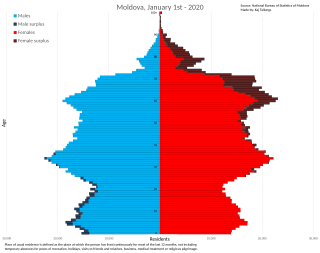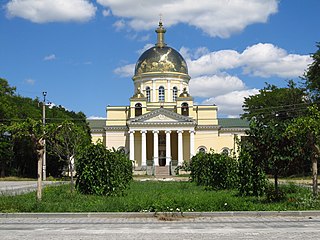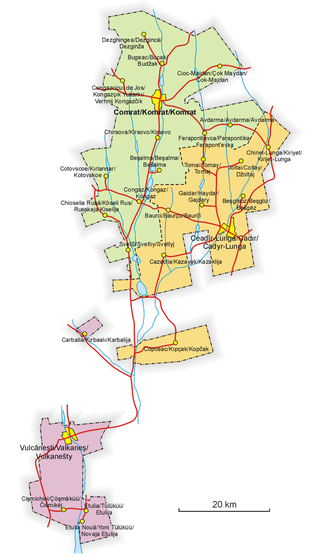The history of Moldova spans prehistoric cultures, ancient and medieval empires, and periods of foreign rule and modern independence.

Demographic features of the population of Republic of Moldova include distribution, ethnicity, languages, religious affiliation and other statistical data.

Bessarabia is a historical region in Eastern Europe, bounded by the Dniester river on the east and the Prut river on the west. About two thirds of Bessarabia lies within modern-day Moldova, with the Budjak region covering the southern coastal region and part of the Ukrainian Chernivtsi Oblast covering a small area in the north.

The Moldavian Soviet Socialist Republic or Moldavian SSR, also known as the Moldovan Soviet Socialist Republic, Moldovan SSR, Soviet Moldavia, Soviet Moldova, or simply Moldavia or Moldova, was one of the 15 republics of the Soviet Union which existed from 1940 to 1991. The republic was formed on 2 August 1940 from parts of Bessarabia, a region annexed from Romania on 28 June of that year, and parts of the Moldavian Autonomous Soviet Socialist Republic, an autonomous Soviet republic within the Ukrainian SSR.

Gagauzia or Gagauz-Yeri, officially the Autonomous Territorial Unit of Gagauzia (ATUG), is an autonomous territorial unit of Moldova. Its autonomy is intended for the local Gagauz people, a Turkic-speaking, primarily Orthodox Christian ethnic group.

Comrat is a city and municipality in Moldova and the capital of the autonomous region of Gagauzia. It is located in the south of the country, on the Ialpug River. In 2014, Comrat's population was 20,113, of which the vast majority are Gagauzians.

Budjak, also known as Budzhak, is a historical region that was part of Bessarabia from 1812 to 1940. Situated along the Black Sea, between the Danube and Dniester rivers, this multi-ethnic region covers an area of 13,188 km2 (5,092 sq mi) and is home to approximately 600,000 people. The majority of the region is now located in Ukraine's Odesa Oblast, while the remaining part is found in the southern districts of Moldova. The region is bordered to the north by the rest of Moldova, to the west and south by Romania, and to the east by the Black Sea and the rest of Ukraine.

Gagauz is a Turkic language spoken by the Gagauz people of Moldova, Ukraine, Russia and Turkey and it is an official language of the Autonomous Region of Gagauzia in Moldova. Gagauz belongs to the Oghuz branch of Turkic languages, alongside Azerbaijani, Turkmen, and Turkish. Gagauz is a distinct language from Balkan Gagauz Turkish to some degree.

Bolhrad is a small city in Odesa Oblast (province) of southwestern Ukraine, in the historical region of Budjak. It is the administrative center of Bolhrad Raion (district) and hosts the administration of Bolhrad urban hromada, one of the hromadas of Ukraine. Population: 14,818.

The Bessarabian Bulgarians are a Bulgarian minority group of the historical region of Bessarabia, inhabiting parts of present-day Ukraine and Moldova.

The flag of Gagauzia has served as an official symbol of the Gagauz Territorial Unit since 1995, and is recognized as a regional symbol by Moldova. Popularly known as the "Sky Flag", it is a triband of blue-white-red, with a wider blue stripe, charged with three yellow stars arranged in triangular pattern. The overall symbolism is debated, but the stars may represent the three Gagauz municipalities within Moldova. The tricolor is reminiscent of the Russian flag, which is also popular in Gagauzia; the issue has created friction between Gagauz and Moldovan politicians.

The history of Gagauzia dates back to ancient times. The larger area, known as Bessarabia, previously the eastern half of the Principality of Moldavia, was annexed by the Russian Empire in 1812. The Gagauz have been ruled by the Russian Empire (1812–1917), Romania, the Soviet Union, and Moldova.

The Bessarabia Governorate was a province (guberniya) of the Russian Empire, with its administrative centre in Kishinev (Chișinău). It consisted of an area of 45,632.42 square kilometres (17,618.78 sq mi) and a population of 1,935,412 inhabitants. The Bessarabia Governorate bordered the Podolia Governorate to the north, the Kherson Governorate to the east, the Black Sea to the south, Romania to the west, and Austria to the northwest. It roughly corresponds to what is now most of Moldova and some parts of Chernivtsi and Odesa Oblasts of Ukraine.

Todur Zanet is a Gagauz and Moldovan journalist, folklorist and poet, one of the most prominent contributors to Gagauz literature and theater. He is the editor-in-chef of Ana Sözü newspaper, which cultivates the Gagauz language, and has written the original anthem of Gagauzia. His activity as a journalist began under Soviet rule, and first peaked during the Perestroika years, when he became involved with the Gagauz nationalist movement.
Russians in Moldova form the second largest ethnic minority in the country. According to the Moldovan Census (2004) and a separate 2004 Census in Transnistria, about 370,000 persons identified themselves as ethnic Russians in Moldova.

Comrat State University is a public university in Comrat, Moldova. It is the successor of the Gagauz National University, founded on 11 February 1991, by the decision of the Russian Education Foundation and the executive committee of Comrat Regional Council of Deputies. In 2002, it became a state university, by the Resolution of the Government of Moldova.

The Gagauz Republic was a self-proclaimed unrecognised political entity, first declared in 1989, that separated from Moldova in 1990 during the dissolution of the Soviet Union but later peacefully joined Moldova after being de facto independent from 1991 to 1995.

Cahul County was a county of the Kingdom of Romania between 1925 and 1938 and between 1941 and 1944, in the historical region of Bessarabia, the successor of Cahul County.

The Comrat Republic was an autonomous republic established in the village of Comrat, in the Bessarabia Governorate, during the Russian Revolution of 1905 in protest of the tsarist regime of the Russian Empire. It was created after a mutiny by Andrey Galatsan, a socialist revolutionary, with the support of the local Gagauz population. It lasted six days and is today viewed positively in Gagauzia as a premonition of the future Gagauz territorial autonomy.

TurkicChristians are ethnic Turkic people who follow Christianity. The Christian Turkic peoples represent an intersection of Turkic and Christian cultural and historical dynamics, particularly within the context of Central Asia and the Caucasus. Historically, the most prominent group within this category were the Bulgars. Currently, The major Christian-Turkic peoples include the Chuvash of Chuvashia, and the Gagauz (Gökoğuz) of Moldova and Yakuts of the Sakha Republic. The vast majority of Chuvash and the Gagauz are Eastern Orthodox Christians.
























